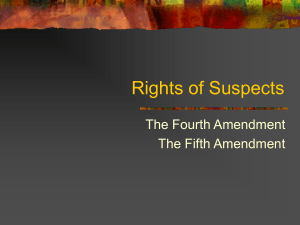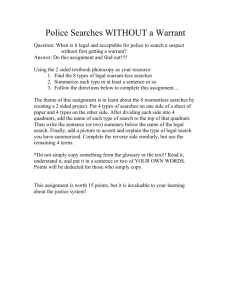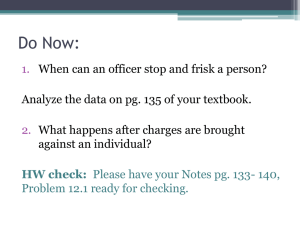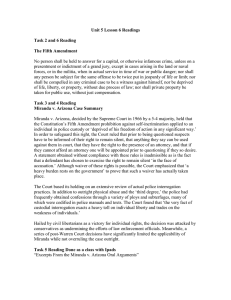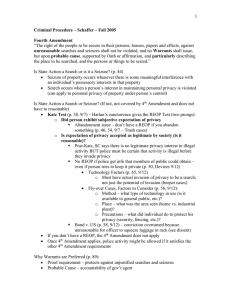document
advertisement
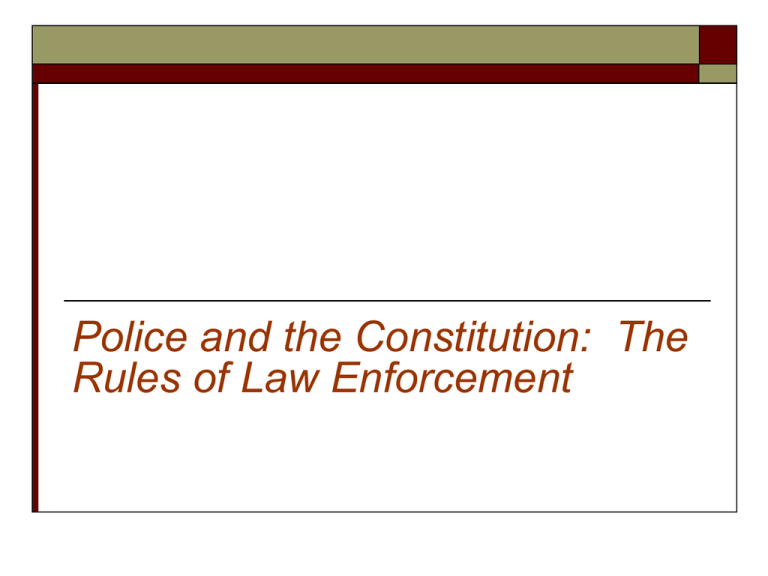
Police and the Constitution: The Rules of Law Enforcement The Fourth Amendment The fourth amendment contains two critical legal concepts: Unreasonable searches and seizures The requirement of probable cause to issue a warrant The Fourth Amendment Sources of Probable Cause: Personal observation Information Evidence Association The Fourth Amendment The Exclusionary Rule: Prohibits the use of illegally obtained evidence in court The Fruit of the Poisoned Tree: Evidence obtained through illegally obtained evidence is also inadmissable The Fourth Amendment Exceptions to the exclusionary rule: Inevitable discovery Brewer v. Williams (1977) Nix v. Williams (1984) Good Faith United States v. Leon (1984) Stops and Frisks A stop is the brief detention of a person by the police for questioning. A stop requires reasonable suspicion. A frisk is a pat-down or minimal search by police to discover weapons. It is conducted for the protection of the officer. Stops and Frisks Stops and Frisks are governed by: Reasonable suspicion Terry v. Ohio (1968) The “totality of the circumstances” Arrests The elements of arrest: The intent to arrest The authority to arrest Seizure or detention The understanding of a person that they have been arrested Arrests Arrests with a warrant: Officers are required to knock and announce their presence. Wilson v. Arkansas (1967). Under certain exigent circumstances officers do not need to announce themselves: The suspect is armed and dangerous. Evidence is being destroyed. A felony is in progress. Arrests Arrests without a warrant: The arrest is committed in the presence of the officer; or The officer has knowledge a crime was committed and probable cause to believe the crime was committed by a particular person. Lawful Search and Seizure The role of privacy in searches: Katz v. United States (1967) A person must show they have an expectation of privacy That expectation must be reasonable Greenwood v. California (1988) Lawful Search and Seizure Search warrants must demonstrate: Information showing probable cause that a crime has been or will be committed. Specific information on the premises to be searched, the suspects to be found and the items to be seized. Lawful Search and Seizure Four categories of items that can be seized by use of a search warrant: Items that resulted from a crime Items that are inherently illegal for anyone to possess Items that can be called “evidence” of a crime Items used in committing the crime Lawful Search and Seizure Searches without a warrant: Searches incidental to arrest United States v. Robinson (1973) The officer’s need to confiscate any weapons the suspect may be carrying The need to protect any evidence on the suspect’s person from being destroyed Chimel v. California (1969) Lawful Search and Seizure Searches without a warrant: Searches with consent Schneckcloth v. Bustamonte (1973) Florida v. Bostick (1991) Searches of automobiles The Carroll Doctrine Whren v. United States (1996) Maryland v. Wilson (1997) Lawful Search and Seizure Searches without a warrant: Plain view doctrine New Hampshire v. Coolidge (1971) The item is positioned in the officer’s view The officer is legally in a position to notice the item The discovery of the item is inadvertent The officer immediately recognizes the illegal nature of the item Lawful Search and Seizure Electronic surveillance can only be used: If consent is given by one of the parties Or there is a warrant authorizing the activity Names the persons under surveillance Details the conversations to be recorded Shows probable cause that a crime has been committed Lawful Search and Seizure Electronic surveillance and national security: The USA PATRIOT Act of 2001 The “sneak and peak” provision National Security Letters The Interrogation Process and Miranda Miranda is required: When a suspect is under arrest And is being questioned about an ongoing investigation This is called custodial interrogation. The Interrogation Process and Miranda The legal basis for Miranda: The Fifth Amendment protection against selfincrimination. The Sixth Amendment right to counsel. Escobedo v. Illinois (1964) Miranda v. Arizona (1966) The Interrogation Process and Miranda Miranda is not required: When police do not ask suspect questions that are testimonial in nature When the police have not focused on a suspect and are questioning witnesses at the scene When a person volunteers information before being asked When the suspect has given a private statement During a stop and frisk when no arrest has been made During a traffic stop The Interrogation Process and Miranda Waivers of Miranda must be knowing and voluntary. To be clear, officers should ask: Do you understand your rights as I have read them to you? Knowing these rights, are you willing to another law enforcement officer or to me?

